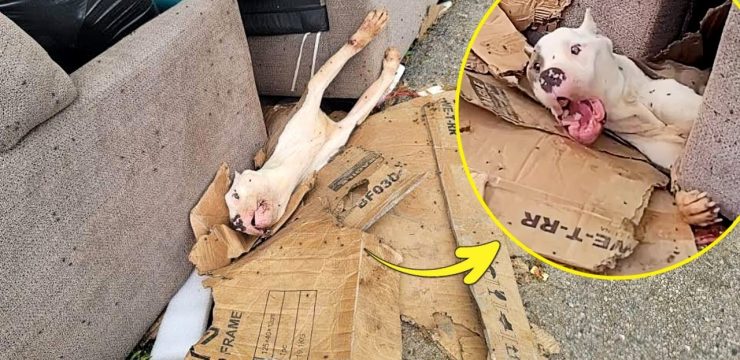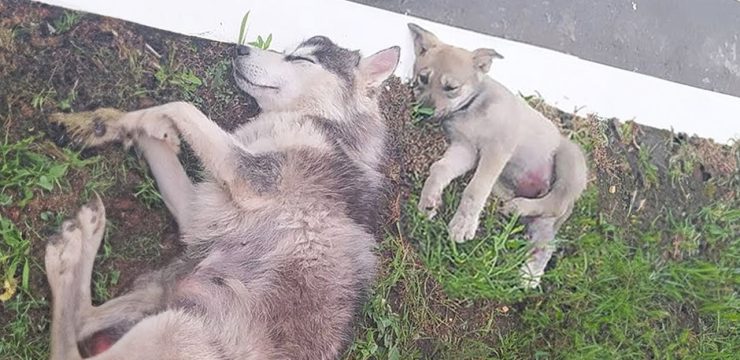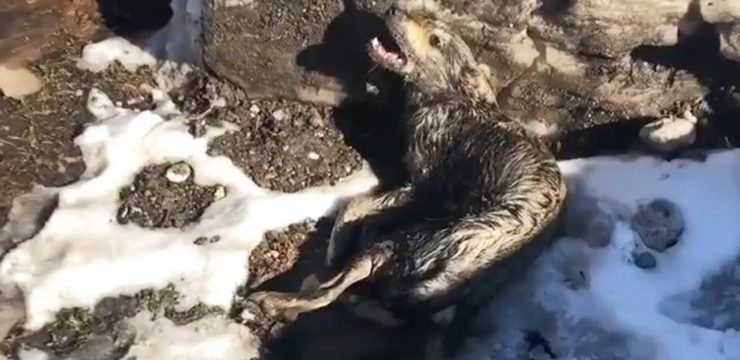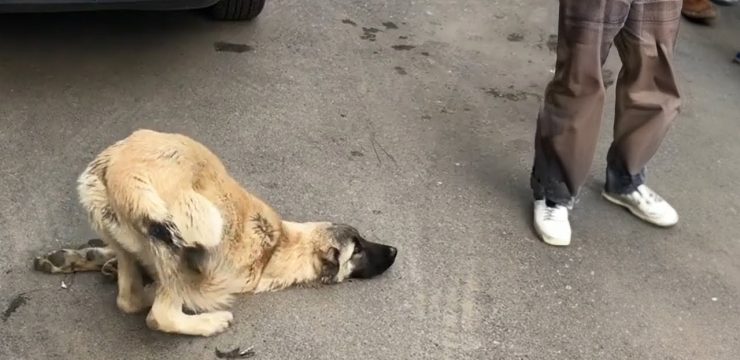It began on a quiet morning in Roraima, Brazil, when neighbors noticed something strange near a patch of overgrown grass along a dusty roadside. They couldn’t quite believe what they were seeing—a small movement inside an old, discarded bag. When they looked closer, their hearts sank. Inside was a weak and trembling dog, barely alive, fighting to breathe. Her muzzle had been tightly bound with rubber tape, cutting deep into her skin. Whoever left her there had done so with shocking cruelty. But this was not where her story would end.

The neighbors immediately called the Military Police, desperate for help. When officers arrived, they were met with a heartbreaking sight. The dog, later named Bella, was lying still, her body covered in ticks, her breathing shallow and labored. The rubber tape around her nose had left deep wounds, and her eyes reflected both terror and pain. The officers worked carefully, cutting away the tape that had silenced her for who knows how long. As soon as it was removed, Bella gasped for air, as if taking her first real breath in days.
Without hesitation, the officers wrapped her in a towel and drove her to a nearby veterinary clinic. During the ride, Bella’s body trembled, unsure if she was being rescued or hurt again. Trauma had taught her not to trust humans. She growled softly, her fear coming out as defensiveness—a natural reaction for a soul that had known only suffering. The rescuer who accompanied her understood this. He didn’t scold or restrain her harshly. Instead, he spoke in a calm voice, gently covering her eyes with his hand to block the frightening sights around her. That simple gesture seemed to give her a small measure of peace.
At the clinic, the examination revealed just how much she had endured. Her frail body was dangerously underweight, every rib visible beneath her thin fur. Dozens of ticks were removed, each one a reminder of how long she had been neglected. Her mouth was badly injured from the prolonged pressure of the tape, leaving painful wounds that made it difficult for her to eat or drink. The vet determined she would need immediate treatment, including antibiotics, wound care, and a blood transfusion to stabilize her. It was touch and go.
The first few days were the hardest. Bella refused to eat and flinched at the slightest touch. She didn’t yet understand that she was safe. Her eyes darted anxiously whenever someone entered the room, expecting more harm. But the rescuer never gave up. He visited her every day, speaking softly and sitting beside her kennel without forcing any interaction. Little by little, she began to recognize that this human was different. He brought her food, water, and comfort without demanding anything in return.
Then, one afternoon, something remarkable happened. When the rescuer extended his hand with a small piece of food, Bella hesitated—but then she took it. It was a small act, but for her, it was a moment of enormous courage. From that day forward, her healing accelerated. She started to wag her tail, just slightly at first, and her eyes softened. The staff at the clinic could see the change: this once broken dog was learning to trust again.
Each week, Bella grew stronger. Her wounds slowly closed, and her coat began to regain its healthy shine. She was fed nutritious meals, given medicine, and showered with gentle affection. She learned that a human hand could offer love instead of pain. When she was finally strong enough to walk, the rescuer took her outside for short strolls. At first, she moved cautiously, sniffing the ground, unsure of her surroundings. But soon her steps became more confident. The sunlight warmed her fur, and for the first time in a long while, she looked genuinely content.
A month later, Bella was almost unrecognizable. The frightened, skeletal dog found in a bag had transformed into a bright, joyful companion. Her tail wagged constantly, and her playful energy filled the clinic. The rescuer, who had been with her from the beginning, couldn’t imagine letting her go. He had fallen deeply in love with her resilience and gentle spirit. So he made a decision that would change both their lives—he adopted her.

Now, Bella lives in a warm and loving home. Her days are filled with long walks, soft blankets, and the quiet security of knowing she is safe. She greets her rescuer every morning with a wagging tail and bright, trusting eyes. The pain of her past has not disappeared, but it no longer defines her. She carries her scars as silent proof of what she survived—and how far compassion can reach.
Bella’s story is not just about one dog’s recovery. It’s a reflection of the incredible capacity for healing that love and patience can bring. Her journey reminds us how powerful kindness can be, even in the face of cruelty. It also shows how many animals silently suffer, waiting for someone to notice, to care, and to act. Every small act of empathy—a call for help, a gentle touch, a decision to rescue—can become the turning point in a life that would otherwise fade away unseen.
Today, Bella stands as a living symbol of hope. She teaches us that no matter how deep the wounds, both physical and emotional, healing is possible. Her transformation—from abandoned and voiceless to loved and joyful—proves that compassion is stronger than cruelty.

Her rescuer says that every time Bella curls up beside him and falls asleep, he feels grateful for the day he answered that call for help. He saved her life—but in many ways, she saved his too. Because in rescuing her, he rediscovered something that so many of us forget: that love, freely given and patiently nurtured, can mend even the most broken heart.
Bella’s story continues to inspire those who hear it, serving as a gentle reminder to treat every living being with respect and care. In a world that often rushes past suffering, she stands as proof that one person’s compassion can make all the difference. And though she can’t speak, her bright eyes say everything: gratitude, trust, and the quiet joy of finally belonging.





